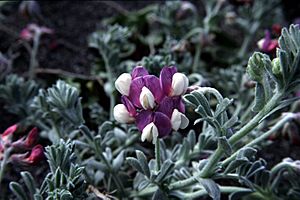Silky beach pea facts for kids
Quick facts for kids Silky beach pea |
|
|---|---|
 |
|
| Scientific classification | |
| Genus: |
Lathyrus
|
| Species: |
littoralis
|
The Lathyrus littoralis is a type of wild pea often called the silky beach pea. This plant grows naturally along the coast of western North America. You can find it from British Columbia in Canada all the way down to California in the United States. It loves to live on sandy beaches and in sand dunes.
Contents
About the Silky Beach Pea
The silky beach pea is a special kind of plant. It is a perennial herb, which means it lives for many years. It grows in patches along the sandy ground. Sometimes, its stems stand up a little bit.
Where Does it Grow?
This plant is found only along the coastline. Its natural home is the sandy areas near the ocean. It thrives in places like beaches and sand dunes.
What Does the Plant Look Like?
The silky beach pea has stems that are gray-green and a bit hairy. Its leaves feel soft and woolly. Each leaf is made up of several smaller, scoop-shaped parts.
The plant also has small, tough tendrils. These are like tiny curly wires. However, unlike many other pea plants, the silky beach pea does not use its tendrils to climb.
Flowers and Fruit
This plant produces many flowers grouped together. Each flower is about one to two centimeters wide. They are very pretty, with two colors. The flowers are deep pink with darker veins, mixed with white parts.
After the flowers, the plant makes fruit. The fruit is an oval-shaped pod. It is also hairy. This pod is a type of legume, which means it's like a bean pod. When it's ripe, it splits open to release its seeds. This splitting open is called dehiscence.
Uses of the Silky Beach Pea
Interestingly, the roots of the silky beach pea are edible. This means they can be eaten by people.

